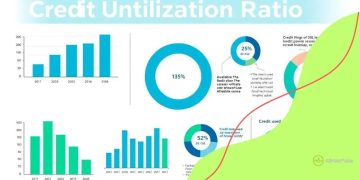Understanding credit utilization ratio: why it matters

Understanding credit utilization ratio is crucial as it impacts your credit score; maintaining a ratio below 30% is recommended for better financial health.
Understanding credit utilization ratio is crucial when it comes to managing your finances. It can influence your credit score more than you might think. Ever wondered how those numbers affect your ability to borrow money or get approved for loans? Let’s dive into it!
What is credit utilization ratio?
The credit utilization ratio is an important financial metric that helps lenders assess your creditworthiness. It is the percentage of your available credit that you are currently using. Understanding this ratio can significantly influence your credit score and overall financial health.
How is it calculated?
Calculating your credit utilization ratio is straightforward. You need two key figures: your total credit limits and your total outstanding balances. To find your ratio, divide your total balances by your total credit limits and multiply by 100. For example, if you have a total credit limit of $10,000 and a balance of $3,000, your ratio would be:
- Credit Utilization Ratio = (3,000 / 10,000) * 100 = 30%
Keeping your ratio below 30% is generally recommended for maintaining a healthy credit score. However, lower is often better.
Why does it matter?
A high credit utilization ratio can signal to lenders that you might be over-relying on credit, which can negatively impact your credit score. Lenders prefer to see that you can manage your credit responsibly. Additionally, if you apply for a new loan, your ratio can affect the interest rates you are offered.
Ensuring that your ratio is low can demonstrate financial responsibility. Regularly monitoring your credit utilization can also help you stay on track. Here are a few tips to improve your ratio:
- Pay down existing debts regularly.
- Request a credit limit increase without increasing your spending.
- Keep old credit accounts open to enhance your available credit.
By keeping an eye on your credit utilization ratio, you can make informed decisions that positively influence your financial future. Monitoring your balances and limits ensures that you are staying responsible and maintaining a healthy financial profile.
How to calculate your credit utilization ratio
Calculating your credit utilization ratio is essential for understanding your financial health. This ratio shows how much of your available credit you are currently using. By keeping track of this number, you can better manage your credit and potentially improve your credit score.
Steps to Calculate
To find your credit utilization ratio, you will need two key pieces of information: your total credit limits from all your accounts and your total outstanding balances. Here’s a simple formula:
- Credit Utilization Ratio = (Total Outstanding Balances / Total Credit Limits) × 100
For example, if you have three credit cards with a total credit limit of $15,000 and you owe $4,500 across those cards, your calculation would look like this:
- Credit Utilization Ratio = (4,500 / 15,000) × 100 = 30%
In this case, you are using 30% of your available credit, which gives lenders a sense of your credit management.
Importance of Monitoring
Monitoring your credit utilization ratio regularly can help you maintain a good credit score. If your ratio goes above 30%, it might indicate overuse of credit, which can hurt your score. It’s wise to check your credit utilization after major purchases or when new credit limits are approved.
To improve your credit utilization ratio, consider these actions:
- Pay off balances regularly to lower your total outstanding amounts.
- Ask for a credit limit increase on your existing accounts.
- Spread your purchases across multiple cards instead of maxing out one card.
By taking these steps, you can ensure that your credit utilization remains at a healthy level, which is beneficial for your overall financial well-being.
The impact of credit utilization on your credit score

The credit utilization ratio plays a significant role in determining your credit score. This ratio shows how much credit you are using compared to your total available credit. Maintaining a low utilization rate can help improve your overall credit health.
How It Affects Your Score
Credit scoring models typically consider your credit utilization in two ways: your overall utilization across all accounts and your utilization on each individual account. A high ratio can signal to lenders that you are overextending yourself financially. This can lead to a lower credit score, making borrowing more difficult.
Generally, it is recommended to keep your credit utilization ratio below 30%. If your ratio exceeds this threshold, it may negatively impact your credit score. For example:
- 30% to 50% utilization might result in a minor score drop.
- Over 50% can lead to a more significant decline.
- Above 70% is often seen as risky by lenders.
What Lenders Look For
Lenders look closely at your credit utilization because it reflects how responsibly you manage credit. A lower ratio indicates you are not overly reliant on borrowed money. This stability is an attractive quality for lenders when considering your loan applications.
To improve your credit utilization ratio, consider regularly paying down your credit card balances. Even small payments can gradually lower your usage percentage. Adding extra payments each month or making payments before the statement period ends can also help prevent high balances from being reported to credit bureaus.
Additionally, you can request higher credit limits on your existing credit cards. Increasing your available credit while keeping your balances the same decreases your utilization percentage, which may enhance your score.
Strategies to manage your credit utilization
Managing your credit utilization ratio effectively is crucial for maintaining a good credit score. There are several strategies you can use to ensure your utilization stays at a healthy level. By following these tips, you can improve how lenders view your creditworthiness.
Regular Payments
One of the simplest ways to manage your credit utilization is to make regular payments. Paying your balance multiple times a month can help keep your total balances low. This approach prevents large amounts from being reported at the end of your billing cycle.
Utilize Automatic Payments
Setting up automatic payments for your credit cards can help ensure you never miss a due date. This practice not only keeps your balances down, but it also helps you avoid late fees, which can negatively affect your credit score.
Requesting Higher Credit Limits
Another effective way to manage your credit utilization ratio is by requesting higher credit limits on your existing accounts. When your credit limit increases, your total available credit rises, reducing your utilization ratio as long as your spending stays consistent.
Diversifying Your Credit Accounts
Having a mix of credit accounts, such as credit cards and loans, can benefit your overall credit profile. This strategy shows lenders that you can manage different types of credit responsibly. Just be mindful to keep your credit utilization low across each account type.
Additionally, ensure you balance your spending across multiple cards instead of maxing out one account. This method helps lower the utilization on each card and keeps your overall ratio in a favorable range.
By implementing these strategies, you can effectively manage your credit utilization ratio and help maintain a strong credit score. Regular monitoring of your credit can also help you remain proactive in your financial management.
Common misconceptions about credit utilization
There are several common misconceptions about credit utilization that can lead to misunderstandings about managing credit effectively. Recognizing these myths is essential for improving your financial health.
Myth 1: Closing Old Accounts Improves Your Score
Many people believe that closing old credit accounts will positively impact their credit score. In reality, closing accounts can lower your overall credit limit, which may increase your credit utilization ratio. Keeping old accounts open, even if they aren’t used regularly, can help maintain a healthy credit utilization.
Myth 2: All Credit Utilization Ranges Are the Same
It’s often thought that all credit utilization ratios are viewed equally by lenders. However, credit scoring models can differ in how they weigh various factors. Generally, a utilization below 30% is advisable, but lower percentages will usually reflect even better on your credit score.
Myth 3: Only Credit Card Balances Matter
Another misconception is that only credit card balances affect credit utilization. In fact, all forms of revolving credit—such as personal lines of credit—play a role in calculating utilization. It’s important to consider all your revolving credit accounts when assessing your utilization ratio.
Myth 4: Paying Off Debt Immediately Fixes Utilization
People often believe that paying off their debt right before a statement cuts will fix their utilization issues. While this is a good practice, it may not always reflect immediately on your credit report. Timing is key, and balances need to be reported low consistently over time to see improvements in your credit score.
Understanding these common misconceptions can help you manage your credit utilization more effectively. By staying informed and making strategic choices, you can build a healthy credit profile.
FAQ – Common Questions About Credit Utilization
What is credit utilization?
Credit utilization is the percentage of your available credit that you are currently using. It impacts your credit score.
How can I improve my credit utilization ratio?
Pay down existing debts, request higher credit limits, and avoid maxing out credit cards. Regular monitoring is also essential.
Does closing old credit accounts help my credit score?
No, closing old accounts can lower your total available credit, which may increase your utilization ratio and negatively impact your score.
Is it bad to have a high credit utilization ratio?
Yes, a high credit utilization ratio can indicate financial stress and may lower your credit score, making it harder to get loans.





